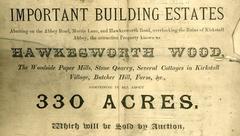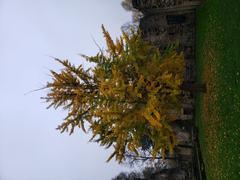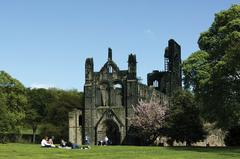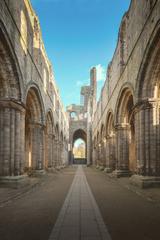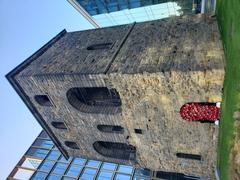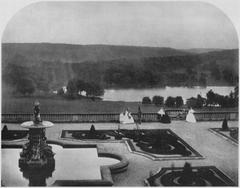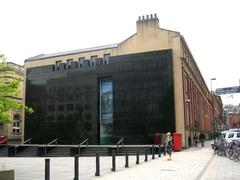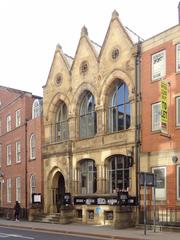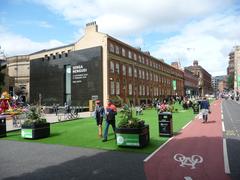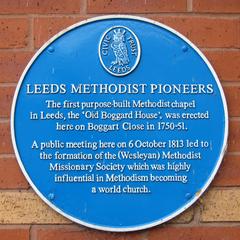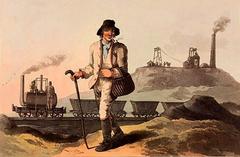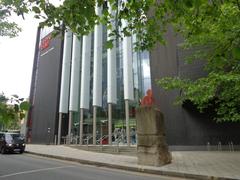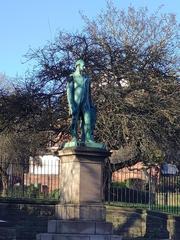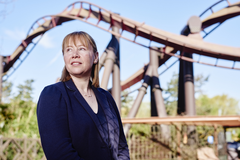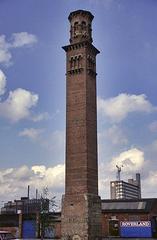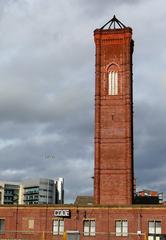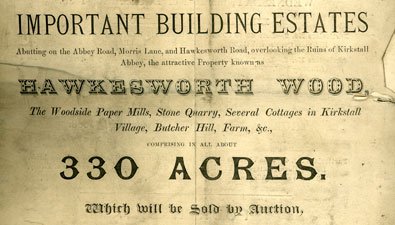
Kirkstall Abbey Leeds: Visiting Hours, Tickets, and Historical Site Guide
Date: 14/06/2025
Introduction: Kirkstall Abbey’s History and Cultural Significance
Kirkstall Abbey, situated on the tranquil banks of the River Aire in Leeds, is among the UK’s most impressive and best-preserved medieval Cistercian monasteries. Established in 1152 by Cistercian monks with the support of Henry de Lacy, the abbey stands as a testament to centuries of spiritual devotion, architectural achievement, and social transformation. Its striking Gothic ruins—marked by soaring arches and weathered gritstone—offer a window into monastic life and the Cistercian ethos of simplicity and functionality (Kirkstall Abbey History; Leeds Magazine).
Today, Kirkstall Abbey is not only a historical site but also a vibrant cultural hub. Regularly hosting community events, open-air concerts, markets, and performances, the abbey serves as a bridge between Leeds’ medieval past and its creative present (Yorkshire.com; Leeds City Magazine). An interactive visitor centre and the adjacent Abbey House Museum further enrich the experience with immersive exhibitions and family-friendly activities.
Accessibility and visitor convenience are at the forefront, with free entry to the ruins, wheelchair-friendly paths, and ample public transport options. Kirkstall Abbey is a must-visit for history enthusiasts, families, and tourists eager to explore Leeds’ medieval roots and contemporary cultural life (Leeds Museums & Galleries; Britain Express).
Table of Contents
- Introduction
- Historical Overview
- Visitor Information
- Kirkstall Abbey in Contemporary Culture
- Exploring Kirkstall Abbey
- Nearby Attractions and Accommodation
- Frequently Asked Questions (FAQ)
- Conclusion
- References
Historical Overview
Foundation and Early Development
Kirkstall Abbey’s foundation in 1152 reflects the religious and social context of medieval England. The Cistercian monks, known for their strict adherence to the Rule of St. Benedict, sought a life of simplicity, manual labor, and communal worship (Kirkstall Abbey History). Henry de Lacy’s patronage—motivated by gratitude after recovering from illness—enabled the monks to settle in the Aire Valley, an area rich in natural resources (WY Humanists).
After an initial failed attempt at Barnoldswick, the monks relocated to Kirkstall, drawn by abundant timber, stone, and water (Kirkstall.org.uk). Construction began in earnest, with the church and chapter house completed by 1182, and the site dedicated to the Virgin Mary (Leeds Magazine).
Architecture and Monastic Life
Kirkstall Abbey is celebrated for the remarkable survival of its core structures, many of which retain their original height (Historic England). Constructed from local gritstone, the complex is defined by its cruciform church, cloister, chapter house, dormitory, and refectory (The Brain Chamber). The Cistercian focus on austerity is evident in the abbey’s functional design and minimal ornamentation.
Monastic life at Kirkstall was governed by a strict daily routine of prayer, work, and study. The monks’ agricultural efforts, especially in sheep farming and the wool trade, established the abbey as a significant economic force, with landholdings extending across Yorkshire (WY Humanists).
Economic and Social Impact
Kirkstall Abbey played a crucial role in the regional economy, particularly through its involvement in the wool trade—a cornerstone of medieval English commerce (Leeds Magazine). The monks also contributed to local technological innovation, including water management and agricultural practices. Despite periods of hardship, the abbey’s fortunes were generally restored through effective stewardship and support from benefactors.
Dissolution and Preservation
The Dissolution of the Monasteries in 1539 marked a turning point. The last abbot, John Ripley, surrendered the abbey peacefully, and its lands and wealth were seized by the Crown (WY Humanists). Unlike many other monastic sites, Kirkstall Abbey’s main structures survived, with portions repurposed for agricultural use (West Leeds Dispatch). The nave even served as a thoroughfare for the Leeds to Skipton road in later centuries.
In the 19th century, efforts to preserve the abbey intensified, culminating in its purchase and donation to Leeds City Council in 1890 (The Brain Chamber). Restoration work stabilized the ruins, ensuring their survival as a heritage site (Wikipedia).
Modern Role and Ongoing Research
Now managed by Leeds Museums & Galleries, Kirkstall Abbey is a Grade I listed site and scheduled ancient monument (Wikipedia). Archaeological digs have unearthed medieval artifacts and architectural details, enriching the site’s interpretation (The Brain Chamber). The adjacent Abbey House Museum, housed in the former gatehouse, complements the medieval experience by recreating Victorian Leeds (What to Do In).
Visitor Information: Hours, Tickets, and Accessibility
Visiting Hours
- Abbey Grounds: Open daily from 8:00 AM to dusk (seasonal variations apply).
- Visitor Centre & Abbey House Museum: Typically open 10:00 AM–5:00 PM, Tuesday to Sunday (closed Mondays; check official site for updates).
Tickets and Admission
- Abbey Ruins: Free entry to the ruins.
- Abbey House Museum: Admission is £6 for adults, £4 for children; family and concession tickets available (Britain Express). Special exhibitions or events may require additional tickets.
- Guided Tours: Available on select days; book via the Leeds Museums & Galleries website.
Accessibility
- Wheelchair-accessible paths and ramps throughout the grounds and visitor centre.
- Accessible toilets and baby-changing facilities on-site.
- Assistance dogs are welcome.
- On-site and accessible parking available.
- For specific needs, contact the visitor centre in advance (Ten Things UK).
Travel Tips and Visuals
- Public Transport: Regular buses from Leeds city centre (routes 33, 34, 757); Headingley and Kirkstall Forge train stations nearby.
- Parking: Free parking opposite Abbey House Museum.
- Best Photography: Golden hour (early morning or late afternoon) is ideal for atmospheric shots (Compare Cheap Flights).
- Virtual Tours: Explore the abbey online via the official website.
Kirkstall Abbey in Contemporary Culture
Artistic Influence
Kirkstall Abbey’s dramatic ruins and riverside setting have inspired renowned artists like J.M.W. Turner and Thomas Girtin (WY Humanists). Its Gothic architecture and tranquil atmosphere continue to attract photographers and creatives (Leeds Inspired).
Events and Community Engagement
The abbey is a sought-after venue for cultural events, including open-air theatre, music festivals, comedy shows, and outdoor cinema (Yorkshire.com). The monthly Kirkstall Abbey Markets (March–October) showcase local food, crafts, and arts (Visit Leeds).
Special exhibitions and art installations, such as the “Trans Saints Project,” further demonstrate the abbey’s role as a space for creative dialogue and community engagement.
Educational Experiences
The visitor centre features interactive exhibits on monastic life, the abbey’s construction, and its lasting impact (Yorkshire.com). Families can enjoy creative workshops and hands-on activities, fostering learning through art and history (Families Online). Audio trails with QR codes offer narrated stories by curators and historians (Leeds Museums & Galleries).
Exploring Kirkstall Abbey: Site Guide
Arrival and Accessibility
- By Bus: Direct services from Leeds centre.
- By Train: Closest stations are Headingley and Kirkstall Forge.
- By Car: Free parking provided opposite Abbey House Museum.
Abbey Grounds and Key Features
- Nave: The abbey’s most intact section, with impressive arches (Thrillophilia).
- Cloisters, Chapter House, Refectory, Abbot’s Lodging: Each area reveals aspects of monastic daily life and hospitality (Britain Express).
- Interpretive Panels: Provide historical context and architectural insights.
Visitor Centre and Abbey House Museum
- Visitor Centre: Offers interactive displays, archaeological finds, and multimedia content (Yorkshire Evening Post).
- Abbey House Museum: Located in the former gatehouse, it recreates Victorian Leeds with reconstructed streets and galleries (Britain Express).
Events and Activities
- Festivals: Kirkstall Festival, Leeds International Beer Festival, open-air theatre, and cinema (What’s On Yorkshire).
- Markets: Monthly artisan and food markets.
- Workshops: Family-friendly creative sessions.
Practical Tips
- Visit on weekdays or during early hours for a quieter experience.
- Dress for the weather—ruins are outdoors.
- Check the events calendar and book tickets in advance for popular events (Leeds Museums & Galleries).
Nearby Attractions and Accommodation
Museums and Parks
- Abbey House Museum: Victorian life exhibits (Abbey House Museum).
- Leeds Industrial Museum at Armley Mills: Showcasing Leeds’ industrial heritage (Leeds Industrial Museum).
- Royal Armouries Museum: Arms and armour displays (Royal Armouries Museum).
- Leeds City Museum: Local history and archaeology (Leeds City Museum).
- Roundhay Park: Expansive parkland and gardens (Roundhay Park).
Walks and Outdoor Activities
- River Aire Walks: Access to Leeds Country Way and Seven Arches Aqueduct routes (Leeds Country Way).
Accommodation
- Hotels in Leeds Centre: Dakota Leeds, Quebecs, Hyatt House, Crowne Plaza, DoubleTree by Hilton, The Queens Hotel.
- Local Hotels: Weetwood Hall Estate, Headingley Lodge, Haley’s Hotel, Premier Inn Leeds Headingley, Ascot Grange Hotel.
- Apartments: Kirkstall Bridge Apartments, Park Mount Residences, Casa Abbey Court.
- Booking: Booking.com, Trivago.
Dining and Amenities
- On-site cafés at Abbey House Museum and visitor centre.
- Restaurants, pubs, and cafés in Headingley and Leeds city centre.
Transport
- Buses (33, 34, 757) stop at Kirkstall Abbey.
- Train stations at Headingley and Kirkstall Forge.
- Taxis and ride-sharing available.
Frequently Asked Questions (FAQ)
Q: What are Kirkstall Abbey’s visiting hours?
A: Abbey grounds are open daily from 8:00 AM to dusk. Visitor centre and museum: 10:00 AM–5:00 PM, Tuesday to Sunday (check for seasonal changes).
Q: Is there an admission fee?
A: Abbey grounds are free. Abbey House Museum charges £6 (adults), £4 (children).
Q: Is the site accessible?
A: Yes, with paved paths, ramps, accessible toilets, and assistance dogs welcome.
Q: Are guided tours available?
A: Yes, bookable via the official website or on-site.
Q: Can I bring my dog?
A: Assistance dogs are welcome; other dogs must be on a lead and are restricted from museum interiors.
Q: Is parking available?
A: Free parking is provided near Abbey House Museum.
Conclusion
Kirkstall Abbey is a remarkable blend of medieval heritage, scenic tranquility, and cultural vitality. Its evocative ruins, engaging exhibitions, and lively events make it a cornerstone of Leeds’ historical and contemporary identity. With accessible facilities, free entry to the abbey grounds, and a host of nearby attractions, Kirkstall Abbey promises a memorable experience for all visitors.
For up-to-date information, event listings, and to enhance your visit, explore the official Kirkstall Abbey website and consider downloading the Audiala app for guided audio tours.
References
- Kirkstall Abbey History, 2016, WY Humanists (link)
- Kirkstall Abbey History, DHI (link)
- Kirkstall Abbey Article, Leeds Magazine (link)
- Kirkstall Abbey Educational Images, Historic England (link)
- The Brain Chamber: Kirkstall Abbey (link)
- What to Do In: Kirkstall Abbey Guide (link)
- Visit Leeds: Kirkstall Abbey (link)
- Yorkshire.com: Kirkstall Abbey (link)
- Leeds Museums & Galleries: Kirkstall Abbey (link)
- Britain Express: Kirkstall Abbey (link)
- Yorkshire Evening Post: Kirkstall Abbey (link)
- West Leeds Dispatch: Kirkstall Abbey History (link)
- Wikipedia: Kirkstall Abbey (link)
